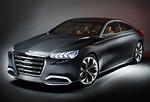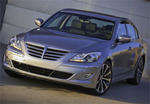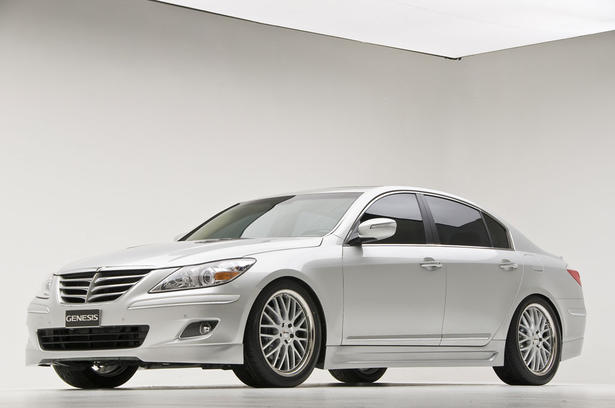
Hyundai unveiled today at the 2008 SEMA show the RKSport Hyundai Genesis Sedan. The RKSport Hyundai Genesis Sedan is powered by a supercharged version of the Tau V8 engine, built by HATCI, that develops 460 hp with the help of an IHI screw-type supercharger and 11 pounds of boost. The RKSport Hyundai Genesis Sedan also features advanced cylinder deactivation technology, which further improves efficiency and fuel savings at cruising speeds. This new tech offers an estimated 18 mpg in city and 27 mpg on the highway.
The European look and feel exterior of the RKSport Hyundai Genesis Sedan features a Platinum Silver color scheme highlights the body kit, exterior components, clean lines and contours of the vehicle. The styling of the RKSport Hyundai Genesis Sedan includes a composite hood, polyurethane front lower fascia, rear lower fascia, left and right side skirts, plus a composite rear roof spoiler and trunk spoiler. RKSport partnered with well-known aftermarket companies to add Enkei Performance LS-5 wheels, a Baer performance brake package, K&N performance air intake, Eibach lowering springs and a Magnaflow performance exhaust.
Hyundai Press Release:
Hyundai America Technical Center, Inc. (HATCI) and RKSport, Inc. teamed up to develop a customized, high-performance Genesis sedan for the 2008 Specialty Equipment Market Association (SEMA) Show. HATCI contributed a supercharged Tau V8 engine with cylinder deactivation technology that boosts output to 460-horsepower and improves fuel economy by up to 8 percent. RKSport customized the recently launched rear-wheel drive Genesis inside and out to help make it one of the main
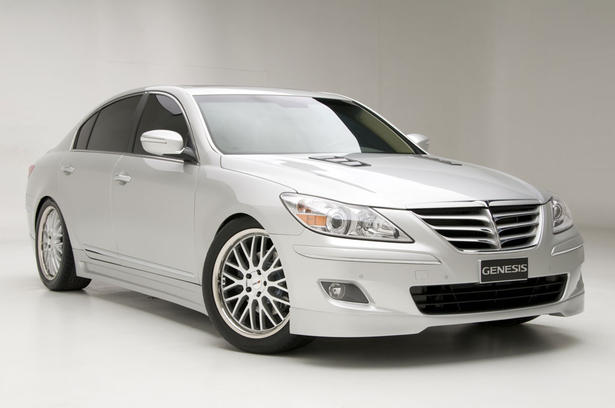
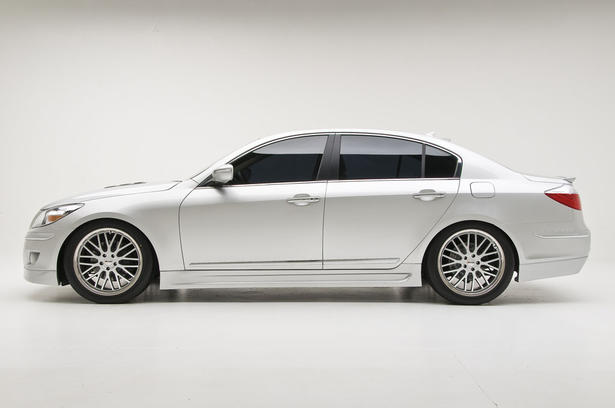
attractions at Hyundai’s booth in the Las Vegas Convention Center from Nov. 4 – Nov. 7, 2008.
“The 2009 Hyundai Genesis provides us a great opportunity to expand on the overall concepts originally designed by Hyundai engineers,” says Bob Smith, owner, RKSport. “We plan to maximize the performance abilities of the Genesis and are looking forward to developing a must-see car at this year’s SEMA show.”
The RKSport/HATCI Genesis is designed with an understated elegance. The Platinum Silver color scheme highlights the body kit, exterior
components, clean lines and contours of the vehicle. Under the skin, the car is powered by Hyundai’s state of the art 4.6-liter Tau engine, which produces 460-horsepower with the help of an IHI screw-type supercharger and 11 pounds of boost for performance driving. The car reaches 60 mph in 4.9 seconds and clicks through the quarter mile gate in 13.58 seconds at 108 mph.
The vehicle also boasts advanced cylinder deactivation technology, which further improves efficiency and fuel savings at cruising speeds. In fact, this Genesis powered by a supercharged
Tau delivers an estimated 18 miles per gallon in city and 27 miles per gallon on the highway which match the fuel economy number of the Genesis 3.8-liter V6.
“The Tau is Hyundai’s first-ever V8 engine and it offers great performance characteristics today with even more potential in the future,” says John Juriga, HATCI powertrain director. “The company designed the Tau with future technologies in mind protecting for boosting, direct injection, cylinder deactivation and more. Advanced technology is a cornerstone of our plans to improve efficiency and fuel economy across our lineup.”
Styling modifications to the RKSport/HATCI Genesis include a modified hood, polyurethane front lower fascia, rear lower fascia, left and right side skirts, plus a composite rear roof spoiler and trunk spoiler. RKSport partnered with well-known aftermarket companies to add TSW alloy wheels, a Baer performance brake package, K&N performance air intake, Eibach lowering springs and a Magnaflow performance exhaust.
POWERPLANT
Although Hyundai has not announced any production intentions for a supercharged version of the Tau V8, HATCI is often tasked by the company with special projects. The team at HATCI has been working on combining a boosted Tau with cylinder deactivation for more than a year and was more than happy to supply the powerplant in the RKSport show car.
Hyundai’s reputation for value is based on efficiency in design, engineering and manufacturing that provides value to the customer, so the HATCI team set about their boosted Tau project with the intention of improving overall fuel efficiency and power. They added cylinder deactivation to improve the fuel economy when highway cruising at light pedal inputs. This Tau engine achieves cylinder deactivation on four cylinders through the addition of latching roller finger followers with oil control solenoids, which de-latch at cruising speeds, thus deactivating intake and exhaust valves. The advanced engine control module regulates cylinder deactivation when the vehicle is not in need of eight-cylinder power. But when the hammer is dropped, this Tau takes on a new personality activating all eight cylinders and stirring in 11 pounds of boost courtesy of an IHI supercharger.
HATCI started with a stock Tau 4.6-liter V8 with a goal of improving performance, but maintaining the engine’s inherent durability and efficiency. To help handle the increased power planned for the boosted engine, several key components were optimized. The cracked metal rods are nearly stock, but feature a robust optimized geometry adding mass in high load areas around the pin bore and shank. The pistons also have a unique design and help provide the optimal reduced 9:1 compression ratio, down from the naturally aspirated model’s 10.2:1. The forged crank shaft is stock. Oil squirters were added to cool the undersides of the pistons during operation.
IHI supplied their screw-type supercharger to pump air to the enhanced engine. The “big mouth” intake increases efficiency of air flow through the unit. HATCI mounted the fuel runners directly to the supercharger to improve the packaging efficiency of the unit. This allowed them to maintain injector spacing and orientation. The intercooler mounts beneath the supercharger in the engine’s “V” despite its inherently tight head-to-head width. The throttle body is located after the supercharger with a Y-adapter feeding air to the plenum. This compact design was part of HATCI’s engineering brief – not only to boost the engine, but to do it with practicality and efficiency. Indeed, the tidy engine and blower assembly tuck neatly under a stock Genesis hood.
Adding power under the hood required some additional enhancements throughout the powertrain. The ZF 6-speed automatic, already a world-class transmission, was built to nominal specifications. Detroit Clutch and Gear provided a beefier two-piece drive shaft with larger, reinforced u-joints. HATCI fabricators replaced the stock exhaust system with a 3-inch OD stainless steel system complete with large-port catalytic converters.








